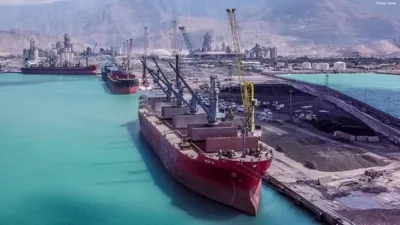
Post by : Anees Nasser
For much of the past few years, inflation dominated global economic headlines: food and energy costs surged, supply chains broke, and central banks hiked rates aggressively. Now, that narrative is shifting. Major inflation components—especially commodities such as oil, grains and energy—are easing. According to recent reporting, commodity prices are heading to a six‑year low, and global headline inflation is projected to continue declining.
This “inflation snap” is significant because it signals a change in several underlying forces: demand softness is emerging, price pressures are easing, and central banks may finally have room to pivot. However, the very same factors that are curbing inflation are also pulling growth lower, meaning the pause in price pressures comes alongside a meaningful slowdown in global economic momentum.
That interplay between easing inflation and slowing growth is critical for policymakers, businesses and investors alike. On one hand, lower inflation can relieve cost burdens and provide breathing space. On the other, the drop in demand and activity that brings inflation down also brings growth risks.
When inflation comes down because supply recovers or cost pressures ease, that is generally positive. But when inflation falls because demand weakens or activity shrinks, the risk for growth rises. In many key economies what we’re seeing is the latter: weaker consumption, falling investment, and trade disruptions.
Commodity prices offer a clear illustration. With oil, grains and metals all under pressure, input costs are dropping. But the drivers of that drop include softer demand—particularly from major consumers and industrial users. Decreased consumption in large economies means export‑oriented sectors face headwinds. Manufacturing and trade growth that once powered expansion are now stalling, which drags growth and in turn dampens inflation pressures further.
In essence: demand weakening → growth slowing → inflation easing. The risk is that growth may slow enough to risk stagnation, rather than just cooling. And when that happens, the inflation relief may prove temporary or incomplete.
The latest global outlooks reinforce this twin dynamic of easing inflation and slowing growth. The International Monetary Fund (IMF) in its October 2025 World Economic Outlook expects global growth to slow to about 3.2 % in 2025 and 3.1 % in 2026. Meanwhile, headline inflation is projected to decline further, though remaining above target in many economies.
Another assessment notes that although inflation is easing—thanks to lower commodity, energy and food prices—many economies still face structural headwinds: ageing populations, weak productivity, elevated debt, and trade fragmentation. These factors are putting a lid on growth even as price pressures ease.
In key emerging economies like India, retail inflation is forecast to fall sharply owing to base‑effects, tax reforms and food‑price declines. But a lower inflation rate alone does not guarantee robust growth; without sufficient domestic demand or export momentum, slower inflation may simply reflect a weaker economy rather than a healthier one.
Certain countries are providing clearer evidence of this slowing trend paired with moderating inflation:
India: Retail inflation is expected to slide further in October, driven by high base effects, GST reforms, and a fall in food prices. Food inflation has turned negative in some segments. This marks a sharp turn from prior years of inflation risk.
China: Growth has moderated as stimulus effects fade and structural reform pressures continue. Investment‑led growth has slowed, property markets remain weak, and demand for commodities is lower than before.
Advanced Economies: Many developed‑market economies now face growth rates close to or below 2 %—well below their longer‑term norms. With inflation easing only gradually, the margin for monetary policy easing remains narrow.
In all these cases, the easing of inflation is accompanied by activity weakness—whether in manufacturing, trade, investment or consumption—which suggests a broader process of deceleration rather than simple rebalancing.
For regions like the Middle East and Asia, the global inflation and growth dynamics have particular importance. Many countries in these regions depend significantly on commodity exports, investment inflows, or trade with major economies such as China, India and the West.
As commodity prices drop, oil‑exporting countries face lower revenues, which may tighten fiscal space and slow infrastructure and public‑sector investment. On the other side, many Asian manufacturing hubs used to benefit from strong global demand; as growth slows in advanced economies and China, export demand may weaken.
Similarly, the easing of inflation globally might reduce input cost pressures for many Asian economies, but without corresponding demand strength, the net effect may be muted: lower cost pressures but also slower growth. Policymakers in these regions will need to navigate this dual‑challenge: retain growth momentum while preparing for lower inflation and possibly tighter global financing conditions.
The new global environment—with slowing growth and easing inflation—poses difficult policy trade‑offs. Central banks and governments have few easy wins. Some key implications:
Monetary policy: With inflation falling, some central banks may begin easing rates. But if growth remains weak, the timing and depth of policy easing become more complex; premature cuts risk reigniting inflation, while delayed cuts risk stalling growth further.
Fiscal policy: With slower growth, government revenues may disappoint. Fiscal stimulus might be called upon, but many countries already carry elevated debt levels, limiting room for manoeuvre.
Structural reforms: The weak‑growth environment underscores the need for productivity improvements, investment in technology, skills and infrastructure. Countries that rely solely on demand stimuli may find limited returns.
Trade and external linkages: Slowing global demand can reduce export‑driven growth. Countries must diversify markets, manage trade risks and build resilience to external shocks.
Commodity‑dependent economies: For exporters of oil, metals, or agricultural commodities, the slump in prices may squeeze budgets and investment plans. They may need to accelerate diversification, reduce subsidies, and shift toward non‑commodity sectors.
And of course, several risks loom: a renewed inflation spike (for example through wage pressures or supply shocks), a sharper‑than‑expected slowdown that triggers recession, or further fragmentation of global trade flows that deepens structural drag.
For businesses and investors, this evolving macro‑environment demands a shift in mindset:
Lower inflation may ease input‑cost pressures, benefiting companies that faced earlier cost headwinds. But slower growth means demand may not ramp up as hoped. Firms will need to manage both cost and volume dynamics carefully.
Investment decisions may tilt toward regions or sectors with growth resilience — such as consumer demand in emerging markets, technology adoption, services over goods, or infrastructure in high‑growth contexts.
For commodity‑driven sectors, a sustained price drop may require rethinking business models, consolidating operations or shifting toward value‑added activities.
For investors, the correlation between inflation, interest rates and growth means asset allocation must adapt: inflation hedges matter less, growth‑sensitive equities may face headwinds, and fixed income strategies may regain appeal if rate cuts are on the horizon.
Several indicators will be critical to monitor in the coming months:
Core inflation: Even as headline inflation eases, core inflation (ex‑food, ex‑energy) will tell us whether the slowdown is broad‑based or superficial.
Manufacturing and services PMI: These surveys provide early signals of demand momentum or weakness.
Commodity and energy prices: Further declines may ease inflation further but also signal deeper growth weakness.
Trade data: Declines in export volumes or orders can signal that global demand is truly slowing.
Policy moves: Central bank decisions, fiscal stimulus announcements, and trade policy responses will matter in how this slowdown evolves.
If growth remains weak for an extended period, the risk shifts from inflation control to growth stagnation or even deflation in certain contexts. In that scenario, policy regimes may have to pivot dramatically from inflation‑fighting to growth‑stimulating.
What is unfolding is not simply a return to “normal” growth and inflation, but a new phase for the global economy—one where past assumptions may no longer hold. The inflation spike of recent years is receding, but the growth engine is also losing steam. For policymakers, businesses and investors, this means adapting to a world of slower growth, lower inflation and greater structural constraints.
The inflation relief is welcome, but it comes with a reminder that the global economy is still vulnerable. Growth has never been so dependent on productivity gains, diversified demand and structural resilience. Economies that succeed in this new phase will be those that accept lower inflation as a backdrop and invest in innovation, competitiveness and strategic adaptation rather than simply hoping for a return to previous growth norms.
In short: yes, inflation may be snapping—but that relief is intertwined with an era of slower growth. The key question now is not just when inflation will fall, but how economies will adjust to it and what they will do to reignite growth.
This article is for informational purposes only. It does not constitute investment, economic policy or financial advice. Readers should consult relevant economic reports, official data and professional advisors before making policy or investment decisions.










Traffic Control Measures Announced for A.R. Rahman Concert at IGI Stadium
Delhi Traffic Police introduces measures near IGI Stadium for A.R. Rahman's concert on Saturday even

Kim Woo-bin and Shin Min-a Tie the Knot After a Decade Together
Actors Kim Woo-bin and Shin Min-a celebrated their marriage in an intimate ceremony in Seoul, markin

Rohit Sharma Set to Play Initial Matches in Vijay Hazare Trophy for Mumbai
Rohit Sharma joins Mumbai’s squad for the opening two Vijay Hazare Trophy matches, spearheaded by Sh

Flight Disruptions at King Khalid International Airport
Friday's operations at King Khalid Airport in Riyadh were hampered by delays and cancellations due t

Kavem Hodge Achieves Second Test Century Against New Zealand
Kavem Hodge's unbeaten century leads West Indies to 381-6, evading follow-on against New Zealand in

Security Heightened in Bangladesh Following Youth Leader's Assassination
In response to the murder of youth leader Sharif Osman Hadi, Bangladesh elevates security measures a